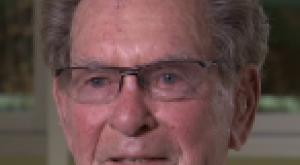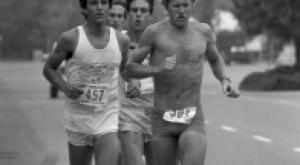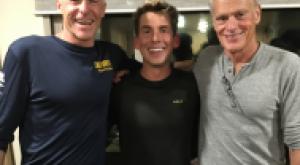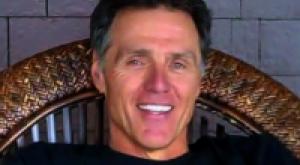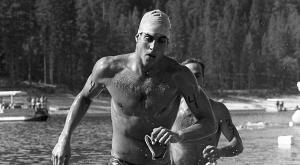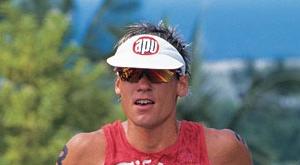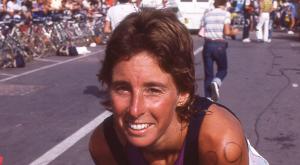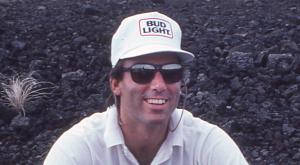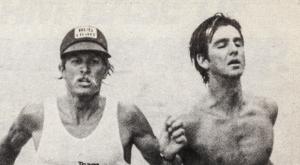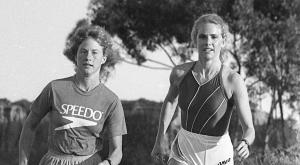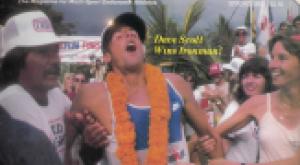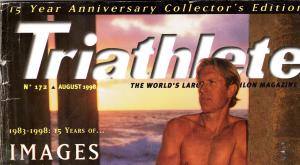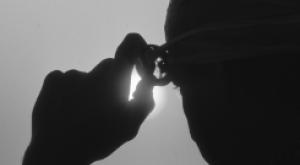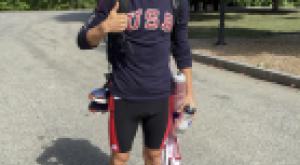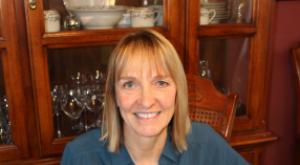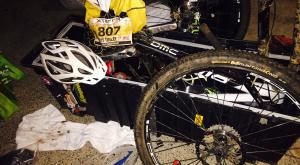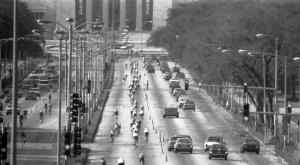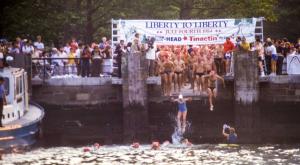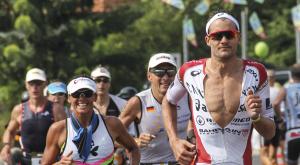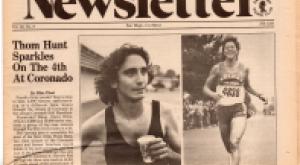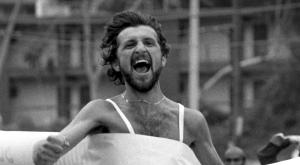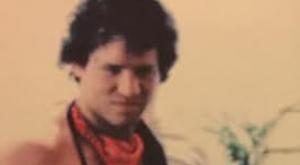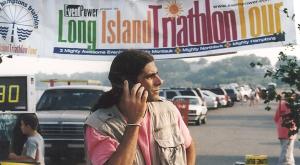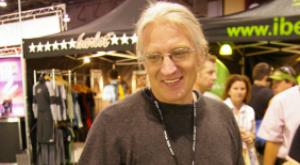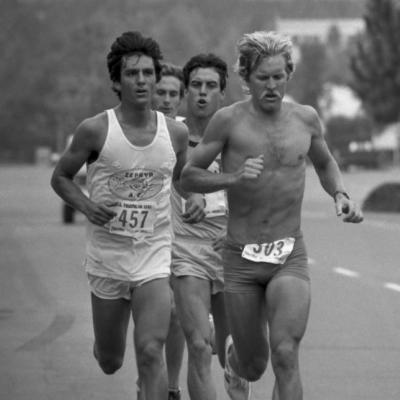
Three members of the soon-to-be-Big Four fight it out in San Diego on June 12, 1982. Scott Molina (front left), Scott Tinley (front right), Dales Basescu (center) and Mark Allen
In the history of triathlon there is perhaps no more significant race than the first U.S. Triathlon Series event on June 12, 1982 at Torrey Pines State Beach in San Diego, California. It was, in retrospect, a rudimentary production, little more than a somewhat tentative proof of a wild-eyed concept born in the brain of one James M. Curl, an entrepreneurial endurance runner and non-practicing lawyer from Davis, California. But in the context of what was at the time the faint whispers of a coming multisport movement, it was The Shot Heard ‘Round the World, a revolutionary leap forward that introduced triathlon to the masses and introduced to triathlon the four men who would dominate the sport for the next decade and more.
As trite as it might sound, it was the race that had everything. In addition to the world premier of the Big Four (Dave Scott, Scott Molina, Scott Tinley and Mark Allen), it was also the launch of Dave Scott’s campaign to take back his Ironman title from Tinley; the first meeting between Tinley and Molina (Tinley introduced himself to a surprised Molina during the run, at top speed); Mark Allen’s first triathlon; the first triathlon to offer prize money in a true, professional sense (significantly, equal for men and women: $800 each); the first rematch between Julie Moss and Kathleen McCartney since the dramatic February 1982 race in Kona. Future triathlon personality Bob Babbitt competed on a relay with his friend and future multi-time world mountain bike champion Ned Overend. Endurance pioneer Sally Edwards was in the field (she finished 2nd in the women’s 30-34 age division). Curl and his soon-to-be business partner, Carl Thomas, were working together under fire for the first time in a trial run for what would become CAT Sports.
It is not an exaggeration to say that the first steps of triathlon’s march toward the Olympic Games were taken on the chilly sand that morning.
Two years later, the USTS would introduce the enduring 1K/40K/10K triathlon format, but the distances in San Diego, and in the four series races that followed in 1982, were 2K/35K/15K. Tinley, a talented runner who acted as a technical advisor on the series to Thomas, is widely blamed for the run-heavy format. He’s been denying the claim for 35 years.
Of the race day coverage of the event that stands out most sharply is a prescient image of the run taken by photographer Diane Johnson. Dave Scott by this point is far up the road (he won the race by two minutes), but the small, tight pack of four runners fighting for second place in Johnson’s rare shot are Tinley, Molina, Dale Basescue, and Allen, whose ultimate greatness, like his position in the pack, is obstructed and slightly out of focus. It is an understated debut, little more than a foreshadowing of his future as a perennial world champion, the Zen Master of triathlon, the Grip of Death.
In all, that day in San Diego featured a total of nine future USA Triathlon Hall of Famers. Here’s how some of the principals recall the day:

The first race, the first day, the first minute, of the U.S.Triathlon Series. Water temp in the low-to-mid 60s, and nary a wetsuit in sight. Not then, and not for years to come.
Did a pre-swim the day before and the swells were light. The water temperature was cold but having tested the waters of SF on numerous occasions, it felt fine. My guess is mid 60’s…I rode out Carmel Valley Road the day before and the road surface was a mess and seemed to quite rural with very little traffic… I had raced Scott Molina in a swim /run in Foster City when he was 15. I was 22 and thought I’d won the race but SM smashed everyone, including me. I never saw him after the gun when off…… I knew he was there in SD for the race…I had met ST in Davis (in 1981) after he froze during a race and ended up crawling up one of the nice homes around Stonegate Lake. There was ice plant surrounding the edges of the luxury homes, and ST used his climbing skill to crawl out after incurring hypothermia. When I saw him at the finish line I thought he was too skinny to be worthy of racing. Hah!... Jim Curl was young stallion from Davis and I knew he would put on a solid race… I assumed everyone will peel off their swim suits after the swim and that’s what happened in T-1. I do recall a number of cameras clicking, but I’m sure everyone was disappointed with the after effects of the cold water…I just raced scared and had no idea how I’d race.


Back in 1982, the triathlon calendar was not brimming with events like it is today. Triathlons were far and few between, and I was excited for another opportunity to race again after Kona. I could feel the sport growing...the number of participants was increasing, the enthusiasm and sense of adventure were tangible and I had the feeling triathlon was really catching on....
I felt quite a bit of pressure heading into the race that day, and knew there were hopes for another “rematch” between Julie and me. Waiting for the gun to go off, I remember thinking that I didn’t stand a chance to be on the podium. Though I was coming off my recent Ironman and two half-Ironman victories, I considered myself a long distance athlete and the 2k-35k-15k format sounded like a sprint.
Playing catch-up after my typical mediocre swim, I had the default strategy to get my legs back and power through the bike, then catch my competitors on the run. It was a relief to pass Julie and move into first place with about a mile to go (and actually see her this time as I ran by). I still had no idea precisely where the finish line was.
It was a fun, tough race packed with amazing competition, and wow, to earn the first prize money in the sport was pretty sweet! I remember being conflicted about cashing my check in case triathlon ever became an Olympic sport...

I don't remember a helluva lot of that period in my life. Everything was a blur as I hardly slept for a few years! I was 22, working two jobs, going to school, had a daughter 11 months old...
Here's what I remember: I was going down there to win some money! I had to. I was broke…
Water was damn cold! No wetsuits. Huge waves. Scary, actually. I thought half of the field would struggle to make it out of the swim…Happy to survive the swim. Can't remember anything about the ride other than it was hilly... On the run, once I got going and heard Dave was a couple of minutes up the road and saw who I was with battling for 2nd I was confident I could get 2nd. I was ready to kill myself to get there. Just ran relaxed... waited ...Was super happy to get 2nd. Thrilled beyond words. Felt like I had found the sport I was made to do. Shortly after the awards ceremony I starting thinking - trying to figure out how I could do this for the rest of my life.
My clearest memory was how shocking it was to run a 15k...I could fake a 10k but after that it was beyond my training, so therefore way beyond my ability. I thought I'd left my suffering back in Kona, but here I was right back in pain purgatory at 10K with three miles still to run. I kept thinking I don't care who passes me as long as I get to the finish and the hurt stops

Julie Moss (center), just four months removed from her dramatic finish at the Ironman, struggles in the 15K run. Leslie Mendez (right) outran her for second.
Tinley: This was the first real professional race (The Horney Toads had offered prize money earlier in the year or the year prior) and it signified legitimacy in what we were trying to do as athletes. As the reigning Ironman champ I was considered the favorite, but Dave—as was born out—came loaded for bear. Scott Molina had scarfed together enough gas money to drive down from Pittsburg, CA and he was not to be denied. Then there was the dark horse State lifeguard, Mark Allen along with a handful of hopefuls like Mark Montgomery, Bill Leach, and Dale Basescu.
Regarding those distances, while I liked the longer run, they were ultimately the decision of Jim and Carl and any “advising” that I did was part and parcel to the grand experiment that was standardizing the sport.
I introduced myself to Molina on the run at mile-2 at a 6-minute mile pace and he looked at me as if I was crazy. We still laugh at that one.
I remember wondering who the goofy guy with the glasses and shaggy hair was that led out of the water (Harald Johnson). I remember Dave riding the bike in a wool jersey. And I don’t remember the awards ceremony because I had to leave early to go to my full-time day job.

Left: Tinley talks to Carl Thomas after the race. In those early days there were few journalists who knew enough about triathlon to conduct an interview. So the television guys often held the camera and the microphone, while race officials did the talking. Right: Tinley, the defending ironman champ, solidly in third place.
Thomas: Crappy little starter pistol (a cap gun!) Leslie Landreth hypothermia......one of the worst I've seen and live to tell about it…Popsicle sticks at the finish Line flying everywhere… How's that for high tech??? Equal prize money men and women-- the entire Series !
(Ed: Landreth was a standout San Diego regional triathlete in the 1980s)

Mark Allen -- Fourth place in his first triathon, with lessons learned.
It felt like the beginning of something big, like the sport was now ready to explode. It was my first triathlon of my life. I was 24. I was inspired, as probably just about everyone there was, by the ABC broadcast of the Ironman (the previous February). I had no real idea what I was doing. I had heard a few names and knew Tinley’s certainly because he’d just won in Kona. I knew Dave because he had been beaten. I was just a guy who was giving it a whirl.
I was just happy to get out of the water…no wetsuits and Torrey Pines was not warm that day. I was passed by Tinley toward the last few miles of the bike and so just tried to hang onto him into transition. I ran a very small bit with him until he pulled away. I ended up next to Dale Basescu. We were 4th and 5th. He pulled away. I had these mental tapes that played in my head from years of swimming that said something like “if the competition pulls ahead even half a stroke the race is over for me”. The tape started to play, but then something switched that became a key turning point in me as a competitor that helped me win many a race in the future. I realized just because someone pulls away, if it’s not the finish, then there’s still hope!
I relaxed, and eventually caught back up to Dale, then pulled away. I ended the day in fourth place behind the three icons of the sport at that time: Dave Scott who won, Scott Molina who stuck it to Tinley in a sprint and got second, and Scott Tinley the reigning Ironman Champion doing the first ever USTS race. On the surface it looked like I might have potential because these were the only three guys ahead of me. But I knew on a very personal level that the potential from that day came from making a shift in those mental tapes that had taken me down so many times as a swimming. Triathlon was fertile ground!
What I remember about the first USTS race in Del Mar was that you felt you were part of something that was going to spread the sport. Jim Curl and Carl Thomas deserve a lot of credit for pulling it off. What was even more impressive was that they pulled it off weekend after weekend through that summer and continued to expand the series year after year.
Another thing that stood out was that the races were a who's-who of the sport, and at that first race you saw many of the non-established athletes there who would go on and dominate the sport for the next two decades, along with the Big Four. If you wanted the best competition you traveled to the USTS races around the country.
With Tinley being the triathlete advisor, no one was very surprised that the run back then was 15K. But hey, if I'd been the advisor maybe I would have made the swim and bike longer with a 5K run at the end. Eventually, the classic Olympic distance became the standard and was more realistic and fair for all concerned.
It came off well and became the model for future triathlons around the world to this day.
One of the things I liked most about triathlon, besides the camaraderie of the athletes, was that each race course was different and with basically five events (two transitions) you always had opportunities to improve, unlike say a 5 or 10K race, where if you didn't PR you might walk away disappointed with your race.

On the run -- Bill Leach, whose wife Julie would win the Ironman lateer that year, in October, was never much a runner, but he was always out of the water at or near the front. As the run developed, Tinley and Molina separated from Allen and Basescue, and overtook Leach. Molina out-kicked Tinley for second place. Allen, who is starting to fade in this shot, finished third.
Can't really sum it all up in a paragraph, as it was the first triathlon we produced, so it was tied into setting up a national series and a business, as well as figuring out how to systematize a lot of operational and race details. My strongest recollection was of being in way over my head. As well, for me, I had a race two, three or four weeks later in LA and no local organization to produce it, so my attention was a bit split.
As far as the athletes, I knew Dave (Scott) pretty well from Davis (I lived there and he was my swim coach), and ST because he knew Carl Thomas and Carl designated ST as our first 'advisor' on triathlon issues in the Fall of 1981 (and the source of the reason why the distances were wonky for two years). I got to know everyone else over the years, and, of course, recollecting the HOF racers involved in the order of finish for the men and women, and the fact that it was the start of a 12-year, 125-event project, USTS–SD 1982 tends to loom large (RIP Dale B.).
Oh yeah, and someone stole our $700 hand-sewn finish banner out from under our noses. Got it back though, and it awaits the physical HOF for a resting place.

Left: A hand-drawn comp of the original USTS logo. The rings would late disappear to avoid conflict with the USOC.
Right: A recent shot of USTS co-founder Jim Curl with the finish banner from the first raace that disappeared during post-race cleanup. It reappeared decades later.

One of the first ads for the inaugural U.S. Triathlon Series in the April, 1982 issue of San Diego Running News. In terms of other publications covering multisports at the time, there were no other choices. Triathlon magazine would not debut for another seven months.
Babbitt: What I remember about that first USTS race was that the mayor of San Diego was there to start the race, which was pretty amazing for a sport that had only been around for a few years. Also, having Ironman champions Scott Tinley and Dave Scott there plus Julie Moss and Kathleen McCartney racing against each other for I think the first time since Julie's collapse and crawl in Kona in February. Also, as someone who wasn't a very good swimmer, i remember how far out in the ocean those buoys were. They were WAY out there!
Johnson: I especially remember the big surf and seeing panic in eyes of the other participants, which had me smiling inside. I loved surf and rough water; the nastier, the better. So the swim was no problem at all. The other two legs? Well, not so much. But that event helped cement the idea of a magazine for the sport in our minds (Penny, Mike, and me). Harald Johnson, along with Mike Gilmore and Penny Little, founded Triathlon magazine. See Harald’s terrific TriHistory piece about the history of Triathlete magazine:
http://www.trihistory.com/features/birth-triathlete-magazine-insiders-story -- Ed.

While the records are unclear, water temperature off Torrey Pines State Beach was probably in the 62-65-degree range. Luckily, most of the athletes were from California and had experience swimming in that kind of water. But there were waves too -- and lots of bodies. It was intimidating for most, exhilarating for others.

Cathy Hoy's original hand-written results list from the first US Triathlon Series race. Electronic timing was little more than a pipe dream in 1982.
See PDF link below to see the entire age group list in its original form.
“I was running (in second place) and heard this noise behind me. I turned around, and there was Tinley, Molina, and Mark Allen. I wasn’t going to let them go. I ran with them to the turnaround and I almost died. I thought I was going to have a heart attack. I got blown away. I was devastated.” (As told to writer Jeffrey Justice in the the May, 1992 issue of Triathlete.) Dale died while training in late 2016 -- Ed.)
I have two memories: The first is Dave Scott introducing himself to me before the race by poking a finger in my chest and announcing that he was going to even the score from the State Fair Swim meet in Sacramento where I beat him in 9 out of 10 events as a young age group swimmer. I told him that wasn’t going to happen because I was the Race Director and not racing…
The second one: Mark Allen pulled into Gina Fleming’s transition spot and spent some time hopping around trying to put on her running shoes. Realizing his mistake, he tossed her shoes away and found his own spot. [I rounded up and returned Gina’s shoes to her spot…]
Mark Allen responds: “Yes, that is true, They were a pair that Nike had given me -- a new model they had just come out with. So there were very few around. I came into the racks, saw the shoes sitting there and racked my bike where the shoes were sitting on the ground. I put one on and it felt really tight. I thought maybe my feet had swollen up. Then as I was putting on the second shoe I finally realized they were not my shoes! I threw them off and started screaming, “Where’s my stuff, where’s my stuff!” Then the lightbulb finally lit and I realized I was in the wrong rack! And yes, they were Gina Fleming’s shoes-- a few sizes too small.
Murphy Reinschreiber was the race director of the first USTS race. Gina Fleming was an outstanding San Diego triathlete, who stumbled into the drama of the Ironman in October, later that same year. It's a great story and it's coming soon to TH -- Ed.

